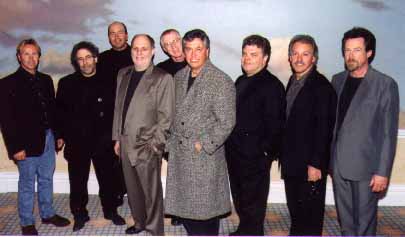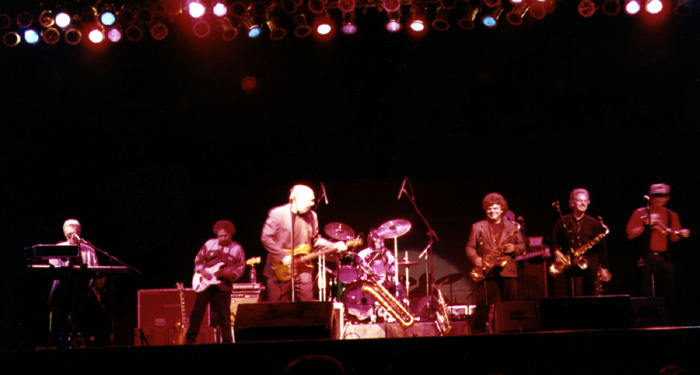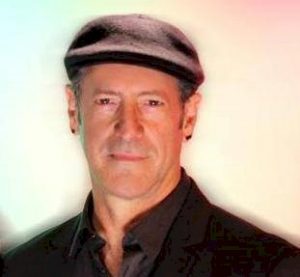
Artist Profile:
Billy Vera
 Billy Vera & the Beaters began in early 1979. Not long after moving to Los Angeles to write songs for Warner Brothers Music, Billy Vera ran into his former bass player from New York, Chuck Fiore. acheter coque iphone en ligne Chuck had moved to L.A. two years earlier and had been playing around town with some good musicians from the local studio scene. He suggested that Billy drop one of the clubs one night to sit in. After renewing their old friendship, the boys found themselves commiserating about their lack of female companionship and figured out that both had “done well” in that department when they were in bands. “Why don’t we start a band….we can meet some girls!” became the rallying cry — and the Beaters were born.
Billy Vera & the Beaters began in early 1979. Not long after moving to Los Angeles to write songs for Warner Brothers Music, Billy Vera ran into his former bass player from New York, Chuck Fiore. acheter coque iphone en ligne Chuck had moved to L.A. two years earlier and had been playing around town with some good musicians from the local studio scene. He suggested that Billy drop one of the clubs one night to sit in. After renewing their old friendship, the boys found themselves commiserating about their lack of female companionship and figured out that both had “done well” in that department when they were in bands. “Why don’t we start a band….we can meet some girls!” became the rallying cry — and the Beaters were born. It was decided that they model the group on the old Little Richard and Ray Charles 50s bands, which included four horns. For a little spice, Billy thought to make it an ’80s version of Bob Wills, not limiting itself to any one genre of music. To help bring this off, the early version of the Beaters included the steel guitar of Steve Fishell (later Jeff “Skunk” Baxter) to offset the R&B sound of the horns. After several months of gigs at local beach clubs, the Beaters were asked to perform every Monday night at midnight at the world famous Troubadour in West Hollywood. “We took the worst night of the week, Monday at midnight, and purposely did no advertising. We wanted to create an underground buzz within the hipster community, so that the opinion makers could discover us on their own,” says Vera, “we figured it would take around six weeks to see if they wanted what we had to offer.”
It was decided that they model the group on the old Little Richard and Ray Charles 50s bands, which included four horns. For a little spice, Billy thought to make it an ’80s version of Bob Wills, not limiting itself to any one genre of music. To help bring this off, the early version of the Beaters included the steel guitar of Steve Fishell (later Jeff “Skunk” Baxter) to offset the R&B sound of the horns. After several months of gigs at local beach clubs, the Beaters were asked to perform every Monday night at midnight at the world famous Troubadour in West Hollywood. “We took the worst night of the week, Monday at midnight, and purposely did no advertising. We wanted to create an underground buzz within the hipster community, so that the opinion makers could discover us on their own,” says Vera, “we figured it would take around six weeks to see if they wanted what we had to offer.”  Apparently, they did. By the second week, the Hollywood cognoscenti were lined up at 11:30 outside the Troubadour to see what became, over the next year, the legendary Billy & the Beaters midnight shows. Soon, every musician worth his salt was begging to join the band or at least sit in. “We didn’t want to be perceived as that kind of band; we wanted to be seen for what we were: our own thing,” says Vera. Indeed, the only performer to ever join the Beaters on-stage at that time was Rickie Lee Jones. Vera explains his choice: “I sensed in her a kindred spirit. She was one of the few singers I’d seen who approached performance the way I did, from the inside out.” That year, 1980, was the year of the Knack and all those “new wave” bands. coque iphone xr Record labels were signing any four piece combo with skinny ties. Interestingly, after their rounds at new wave clubs, A&R men would inevitably wind up at the Troubadour to catch the Beaters’ set. “I’d see them out there tapping their feet and digging what we were doing, but nobody was reaching for his checkbook.” By the end of the year, “new wave” had run it’s course and the record companies were looking for something new and different and the Beaters were nothing if not different. “Capitol and Polygram began sniffing around, sounding like they were about to make an offer, but I ultimately chose to go with Alfa because [A&R man] Lorne Saifer understood what I was trying to do,” recalls Vera. It was decided to record the band “live” because that’s where their excitement was best showcased. When a deal could not be cut with the Troubadour’s management, the Roxy on the famed Sunset Strip stepped in. For three nights, Wally Heider’s recording trucks captured the excitement of Hollywood’s favorite sons, playing to a packed house of fans who had come to see them every Monday night for a year. The resulting album, Billy & the Beaters, with it’s bold black and white graphic design, was an instant classic, begetting the hit single “I Can Take Care Of Myself.” Meanwhile, Alfa’s owners in Japan were becoming increasingly dissatisfied with their American management and began to pull the plug, leaving Billy & the Beaters’ follow-up single, “At This Moment,” to founder on the lower reaches of the charts. A second album, cut in the studio, was deemed unacceptable and remains in the vaults to this day. Billy’s old mentor from his Atlantic Records days, Jerry Wexler, was deputized to produce a Billy Vera solo album in Muscle Shoals, Alabama, combining several Beaters with Southern Soul veterans of countless records the likes of Aretha Franklin and Wilson Pickett. By the time of the album’s release, US Alfa was a sinking ship, unable to give the record more than perfunctory promotion and it sank with hardly a trace. For the next four years, Billy Vera & the Beaters played Southern California to loyal crowds, until one day came the golden phone call. “This guy calls me and says he’d been to see band the over the weekend,” recalls Vera, “He’d heard us do a tune which he wanted to use on this show he was producing called Family Ties. “The song, of course, was “At This Moment.” After the first episode in which the song was used, in the fall of 1985, Vera received “a bag full of mail” from NBC. This encouraged him to canvass major labels in hopes he’d be allowed to re-record it as a single. coque iphone 7 When he’d been turned down virtually everyone, a meeting with Rhino Records chief Richard Foos, whom he knew socially, resulted in a commitment the label to reissue a compilation Vera of the most requested items from his two Alfa albums. Vera tells it from here: “By the time Rhino released the album, we missed the summer reruns. Then Lady Luck stepped in and, in the first show of the 1986 season, “At This Moment” was used on the episode where Michael J. Fox’s character loses his girlfriend. The story of the song: boy loses girl, matched the story on the episode and, bang, America went nuts.” In one of those rare instances of a true grass roots uprising, the public responded to the song and propelled it–without promotion or payola–to number one on the national sales charts. Concurrently, the band had been working on a pair of movies, Blake Edwards’ Blind Date, starring Bruce Willis and Kim Basinger, and the ABC movie-of-the-week, Tonight’s The Night. Director Bob Roth recalled editing the film as “At This Moment” barreled up the charts: “I kept getting calls from the network brass, telling me to beef up Billy’s footage in the movie. By the time I was finished, it looked like a Billy Vera video!” The success of “At This Moment” changed the lives of Billy and everyone in the band. One of Vera’s dreams, of appearing on American Bandstand, finally came true, thirty years after he first watched the show. Dick Clark and his wife Carrie became staunch fans and supporters, including the Beaters on a number of Clark’s productions and utilizing Billy as a presenter on his American Music Awards. coque iphone xs max Many television and movie appearances followed, including one as a western swing band in the film version of Dan Jenkins’ Baja Oklahoma , in which the Beaters back Willie Nelson and Billy was cast as the drunken ex-boyfriend of Leslie Ann Warren. As free agents with a number one record, calls began to pour in from record company presidents. Vera chose Capitol Records after a call from head honcho Joe Smith. Another old Atlantic Records pal, Tom Dowd, was hired to produce the album, Retro-Nuevo, which spawned a top ten Adult Contemporary hit, “Between Like And Love. coque iphone 7 “The tune, along with Billy’s “Hopeless Romantic,” from the Rhino album, were used extensively on the NBC soap opera Days Of Our Lives. Vera performed two other songs from the album, “Poor Boys” and “Ronnie’s Song,” in his featured role on the CBS series Wise Guy , which concluded with his character being reluctantly shot in the back one of the show’s leads. Despite this exposure, the album failed to ignite and, before too long, Billy Vera & the Beaters were back playing Los Angeles area clubs, playing the music they love for their loyal following. From mid-1990 to early 1991, Billy and the band were tapped to be the house band on ABC’s venture into the late night talk show field, Into The Night , starring Rick Dees.
Apparently, they did. By the second week, the Hollywood cognoscenti were lined up at 11:30 outside the Troubadour to see what became, over the next year, the legendary Billy & the Beaters midnight shows. Soon, every musician worth his salt was begging to join the band or at least sit in. “We didn’t want to be perceived as that kind of band; we wanted to be seen for what we were: our own thing,” says Vera. Indeed, the only performer to ever join the Beaters on-stage at that time was Rickie Lee Jones. Vera explains his choice: “I sensed in her a kindred spirit. She was one of the few singers I’d seen who approached performance the way I did, from the inside out.” That year, 1980, was the year of the Knack and all those “new wave” bands. coque iphone xr Record labels were signing any four piece combo with skinny ties. Interestingly, after their rounds at new wave clubs, A&R men would inevitably wind up at the Troubadour to catch the Beaters’ set. “I’d see them out there tapping their feet and digging what we were doing, but nobody was reaching for his checkbook.” By the end of the year, “new wave” had run it’s course and the record companies were looking for something new and different and the Beaters were nothing if not different. “Capitol and Polygram began sniffing around, sounding like they were about to make an offer, but I ultimately chose to go with Alfa because [A&R man] Lorne Saifer understood what I was trying to do,” recalls Vera. It was decided to record the band “live” because that’s where their excitement was best showcased. When a deal could not be cut with the Troubadour’s management, the Roxy on the famed Sunset Strip stepped in. For three nights, Wally Heider’s recording trucks captured the excitement of Hollywood’s favorite sons, playing to a packed house of fans who had come to see them every Monday night for a year. The resulting album, Billy & the Beaters, with it’s bold black and white graphic design, was an instant classic, begetting the hit single “I Can Take Care Of Myself.” Meanwhile, Alfa’s owners in Japan were becoming increasingly dissatisfied with their American management and began to pull the plug, leaving Billy & the Beaters’ follow-up single, “At This Moment,” to founder on the lower reaches of the charts. A second album, cut in the studio, was deemed unacceptable and remains in the vaults to this day. Billy’s old mentor from his Atlantic Records days, Jerry Wexler, was deputized to produce a Billy Vera solo album in Muscle Shoals, Alabama, combining several Beaters with Southern Soul veterans of countless records the likes of Aretha Franklin and Wilson Pickett. By the time of the album’s release, US Alfa was a sinking ship, unable to give the record more than perfunctory promotion and it sank with hardly a trace. For the next four years, Billy Vera & the Beaters played Southern California to loyal crowds, until one day came the golden phone call. “This guy calls me and says he’d been to see band the over the weekend,” recalls Vera, “He’d heard us do a tune which he wanted to use on this show he was producing called Family Ties. “The song, of course, was “At This Moment.” After the first episode in which the song was used, in the fall of 1985, Vera received “a bag full of mail” from NBC. This encouraged him to canvass major labels in hopes he’d be allowed to re-record it as a single. coque iphone 7 When he’d been turned down virtually everyone, a meeting with Rhino Records chief Richard Foos, whom he knew socially, resulted in a commitment the label to reissue a compilation Vera of the most requested items from his two Alfa albums. Vera tells it from here: “By the time Rhino released the album, we missed the summer reruns. Then Lady Luck stepped in and, in the first show of the 1986 season, “At This Moment” was used on the episode where Michael J. Fox’s character loses his girlfriend. The story of the song: boy loses girl, matched the story on the episode and, bang, America went nuts.” In one of those rare instances of a true grass roots uprising, the public responded to the song and propelled it–without promotion or payola–to number one on the national sales charts. Concurrently, the band had been working on a pair of movies, Blake Edwards’ Blind Date, starring Bruce Willis and Kim Basinger, and the ABC movie-of-the-week, Tonight’s The Night. Director Bob Roth recalled editing the film as “At This Moment” barreled up the charts: “I kept getting calls from the network brass, telling me to beef up Billy’s footage in the movie. By the time I was finished, it looked like a Billy Vera video!” The success of “At This Moment” changed the lives of Billy and everyone in the band. One of Vera’s dreams, of appearing on American Bandstand, finally came true, thirty years after he first watched the show. Dick Clark and his wife Carrie became staunch fans and supporters, including the Beaters on a number of Clark’s productions and utilizing Billy as a presenter on his American Music Awards. coque iphone xs max Many television and movie appearances followed, including one as a western swing band in the film version of Dan Jenkins’ Baja Oklahoma , in which the Beaters back Willie Nelson and Billy was cast as the drunken ex-boyfriend of Leslie Ann Warren. As free agents with a number one record, calls began to pour in from record company presidents. Vera chose Capitol Records after a call from head honcho Joe Smith. Another old Atlantic Records pal, Tom Dowd, was hired to produce the album, Retro-Nuevo, which spawned a top ten Adult Contemporary hit, “Between Like And Love. coque iphone 7 “The tune, along with Billy’s “Hopeless Romantic,” from the Rhino album, were used extensively on the NBC soap opera Days Of Our Lives. Vera performed two other songs from the album, “Poor Boys” and “Ronnie’s Song,” in his featured role on the CBS series Wise Guy , which concluded with his character being reluctantly shot in the back one of the show’s leads. Despite this exposure, the album failed to ignite and, before too long, Billy Vera & the Beaters were back playing Los Angeles area clubs, playing the music they love for their loyal following. From mid-1990 to early 1991, Billy and the band were tapped to be the house band on ABC’s venture into the late night talk show field, Into The Night , starring Rick Dees.


